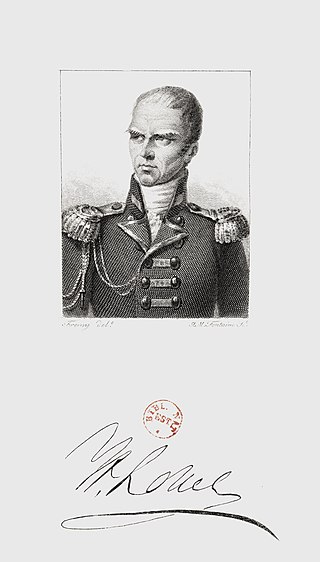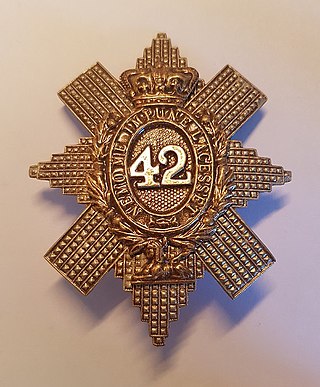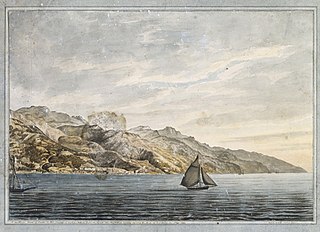
Filippo Antonio Pasquale de' Paoli was a Corsican patriot, statesman, and military leader who was at the forefront of resistance movements against the Genoese and later French rule over the island. He became the President of the Executive Council of the General Diet of the People of Corsica and wrote the Constitution of the state.

Sir Hudson Lowe was an Anglo-Irish General during the French Revolution and Napoleonic Wars who is best known for his time as Governor of St Helena, where he was the jailor of Emperor Napoleon.

Lieutenant General The Right Honourable Sir Thomas Maitland was a British soldier and British colonial governor. He also served as a Member of Parliament for Haddington from 1790 to 1796, 1802–06 and 1812–13. He was made a Privy Councillor on 23 November 1803. He was the second surviving son of James Maitland, 7th Earl of Lauderdale, and the younger brother of James Maitland, 8th Earl of Lauderdale. Maitland never married.

Lieutenant-General Sir Charles Stuart was a British Army officer and politiciain. The fourth son of John Stuart, 3rd Earl of Bute and Mary Wortley Montagu, he was born in Kenwood House, London. There is a famous painting in the Tate Gallery, London, of him aged 10 stealing eggs and chicks from a bird's nest.

The 42nd Regiment of Foot was a Scottish infantry regiment in the British Army also known as the Black Watch. Originally titled Crawford's Highlanders or the Highland Regiment and numbered 43rd in the line, in 1748, on the disbanding of Oglethorpe's Regiment of Foot, they were renumbered 42nd, and in 1751 formally titled the 42nd (Highland) Regiment of Foot. The 42nd Regiment was one of the first three Highland Regiments to fight in North America. The unit was honoured with the name Royal Highland Regiment in 1758. Its informal name Black Watch became official in 1861. In 1881, the regiment was amalgamated with 73rd (Perthshire) Regiment of Foot under the Childers Reforms into The Royal Highland Regiment , being officially redesignated The Black Watch in 1931. In 2006, the Black Watch became part of the Royal Regiment of Scotland.
General Sir John Oswald was a prominent British Army officer during the French Revolutionary and Napoleonic Wars whose service was conducted in seven different theatres of war. Oswald was born in Fife and educated in France, which gave him both excellent command of the French language and close connections with the French aristocracy. The excesses of the French Revolution gave him a hatred of the French Republic and later Empire, and his exemplary service in the West Indies, the Netherlands, Malta, Italy, Egypt, the Adriatic and finally the Peninsular War demonstrated both his keen tactical and strategic understanding his and personal courage.

The Royal Corsican Rangers was a unit of the British Army, composed mainly of émigrés, which served during the later part of the French Revolutionary Wars and throughout the Napoleonic Wars.

Jacques Pierre Abbatucci was a Corsican who became an officer in the army of Genoese Corsica, Ancien regime France and the First French Republic.

The siege of Calvi was a combined British and Corsican military operation during the Invasion of Corsica in the early stages of the French Revolutionary Wars. The Corsican people had risen up against the French garrison of the island in 1793, and sought support from the British Royal Navy's Mediterranean Fleet under Lord Hood. Hood's fleet was delayed by the Siege of Toulon, but in February 1794 supplied a small expeditionary force which successfully defeated the French garrison of San Fiorenzo and then a larger force which besieged the town of Bastia. The British force, now led by General Charles Stuart, then turned their attention to the fortress of Calvi, the only remaining French-held fortress in Corsica.

The siege of Bastia was a combined British and Corsican military operation during the early stages of the French Revolutionary Wars. The Corsican people had risen up against the French garrison of the island in 1793, and sought support from the British Royal Navy's Mediterranean Fleet under Lord Hood. After initial delays in the autumn, Hood had supplied a small expeditionary force which had successfully driven the French out of the port of San Fiorenzo in February 1794. Hood then turned his attention to the nearby town of Bastia, which was held by a large French garrison.

Lieutenant-General Sir Hildebrand Oakes, 1st Baronet, GCB was a British Army officer.

William Goodison (1785–1836) was an assistant surgeon of the British Army. He was born in 1785 in the county of Wicklow, Ireland. His father, William Goodison, was a pharmacist and urged his son to study under professor Austin of Trinity College, Dublin. William Goodison entered Trinity College at the age of 16, in 1801, and concluded his studies in the spring of 1807 by obtaining a B.A.. He ranked the Medical Service of the British Army on 23 August 1810. He was placed an assistant surgeon of the 75th Regiment of Foot, a position previously held by John Cumine. He served this post until 4 March 1824, when he was reduced on half-pay and moved to the 25th Regiment of Light Dragoons, until his death in August 1836.

The Sicilian Regiment was a light infantry regiment recruited from Sicily that served with the British Army during the Napoleonic wars, from 1806 to its disbandment in 1816.
The 1st Regiment Greek Light Infantry (1810–12) was a light infantry regiment, founded as a local establishment in British service consisting mostly of Greek and Albanian enlisted men and Greek and British officers that served during the Napoleonic Wars. Later it became a regular British Army regiment as the 1st Greek Light Infantry (1812–16). It had no official association with the modern state of Greece or the Filiki Eteria or any Greek War of Independence groups; however, several future leaders of the War of Independence fought in its ranks, as did a number of rank-and-file klephts and armatoloi.
Lieutenant-General William Anne Villettes, was a senior officer of the British Army during the early nineteenth century. His career saw service in the Mediterranean, particularly during the Invasion of Corsica in 1794 and at the Malta Protectorate after British occupation in 1800. He died in 1808 while serving as military commander in British Jamaica and is buried at Half Way Tree.

General Sir Henry Tucker Montresor was a general in the British Army.
General Frederick Rennell Thackeray was a senior British Army officer.
The Royal Malta Fencible Regiment was an infantry battalion of the British Army which existed from 1815 to 1861 in Malta, then a British colony. The regiment was recruited and organised by Francesco Rivarola in 1815; Rivarola had proved himself loyal to the British Crown in fighting France. In 1861 the regiment was disbanded as an infantry unit and designated as a coastal artillery defence regiment, becoming the Royal Malta Fencible Artillery.

The 1813–1814 Malta plague epidemic was the last major outbreak of plague on the islands of Malta and Gozo. It occurred between March 1813 and January 1814 on Malta and between February and May 1814 on Gozo, and the epidemic was officially declared to be over in September 1814. It resulted in approximately 4500 deaths, which was about 5% of the islands' population.
The siege of Santa Maura in March and April 1810 was fought between the British and the French troops on the island of Lefkada. Santa Maura had belonged to the First French Empire since 1807, and was garrisoned by a mixed force of French regulars and men of the locally raised, Greco-Albanian Albanian Regiment. The British troops that landed on the island were also supported by Greek and Corsican volunteer troops. Mistrust of the Greco-Albanian troops by the French command, and the presence of Greeks in the British force, resulted in the defection of the Albanian Regiment's men to the British, hastening the surrender of the island.













